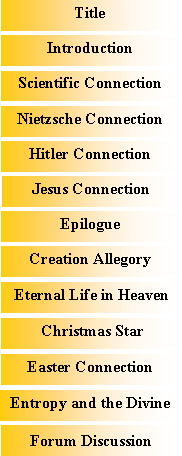|
How the Existentialism of Friedrich Nietzsche Finds Expression in the Narrative of Jesus the Christ |
|
This site explores how the mysteries of Christian resurrection and transfiguration exemplify the philosophy of Friedrich Nietzsche and† His Eternal Return of the ‹bermensch. Raphael, himself one of those immortal naÔves, in one of his allegorical paintings depicted that reduction of illusion to mere illusion, the original act of the naÔve artist and also of Apolline culture. In his Transfiguration, the lower half of the painting, with the possessed boy, his despairing bearers, the dismayed and terrified disciples reveals the reflection of eternal, primal suffering, the sole foundation of the world: 'illusion' here is the reflection of the eternal contradiction, of the father of all things. From this illusion there now arises, like an ambrosial vapour, a new and visionary world of illusion of which those caught up in the first illusion see nothing - a radiant floating in the purest bliss and painless contemplation beaming from wide-open eyes. Here, in the highest artistic symbolism, we behold that Apolline world of beauty and its substratum, the terrible wisdom of Silenus, and we intuitively understand their reciprocal necessity. Friedrich Nietzsche, The Birth of Tragedy. |


|
†††††††††††††††††††††††††††††††††††††††††††††††††††††††††††††††††††††††††††††††††††††††† Contact us at mythoughts@mountdivination.net |
